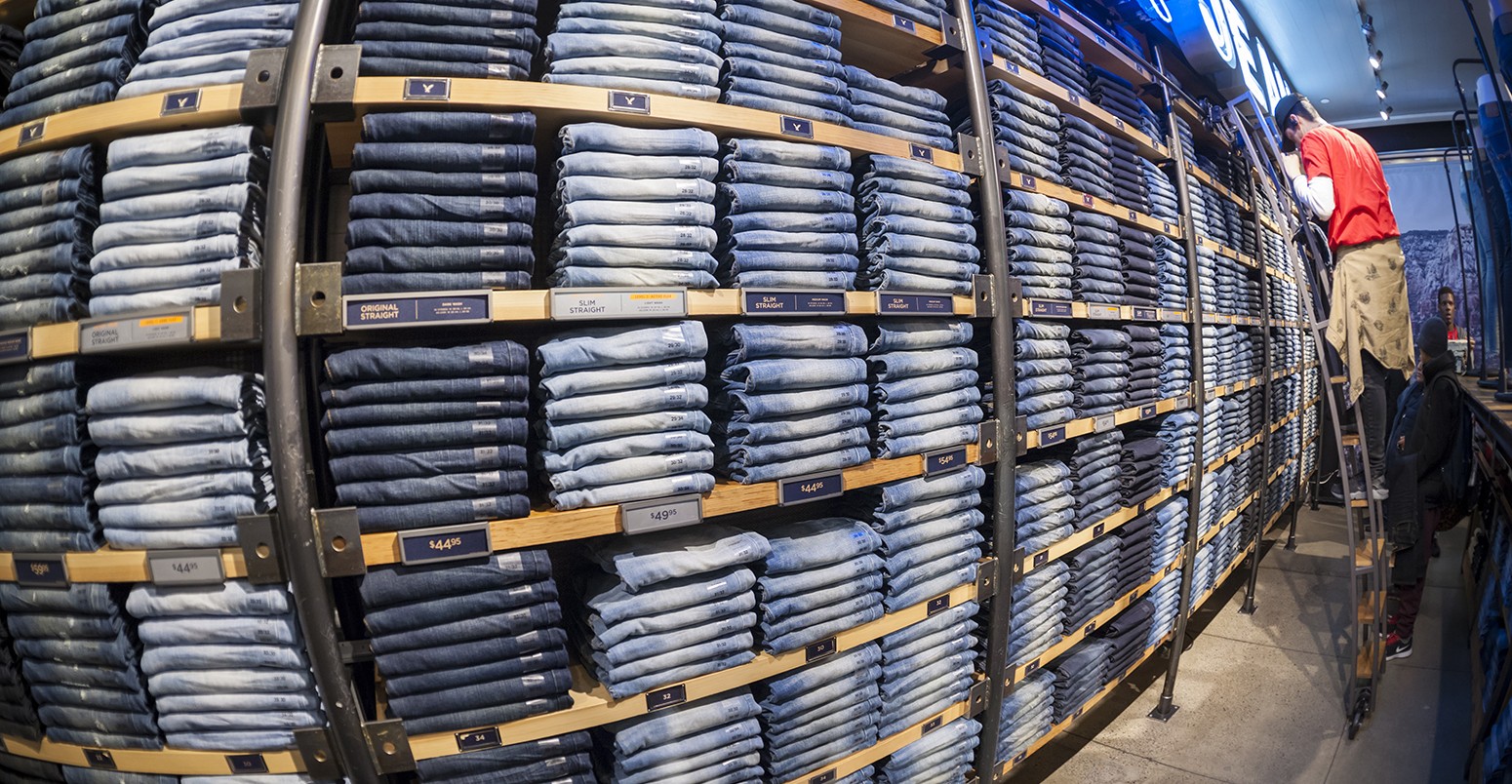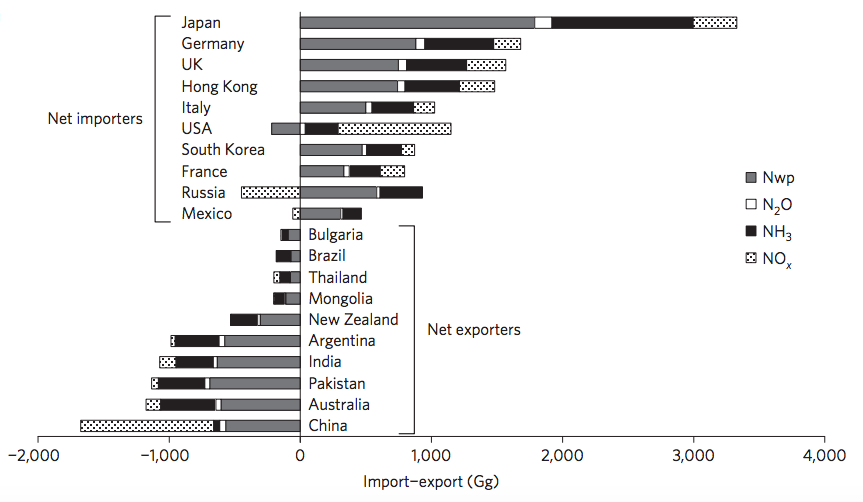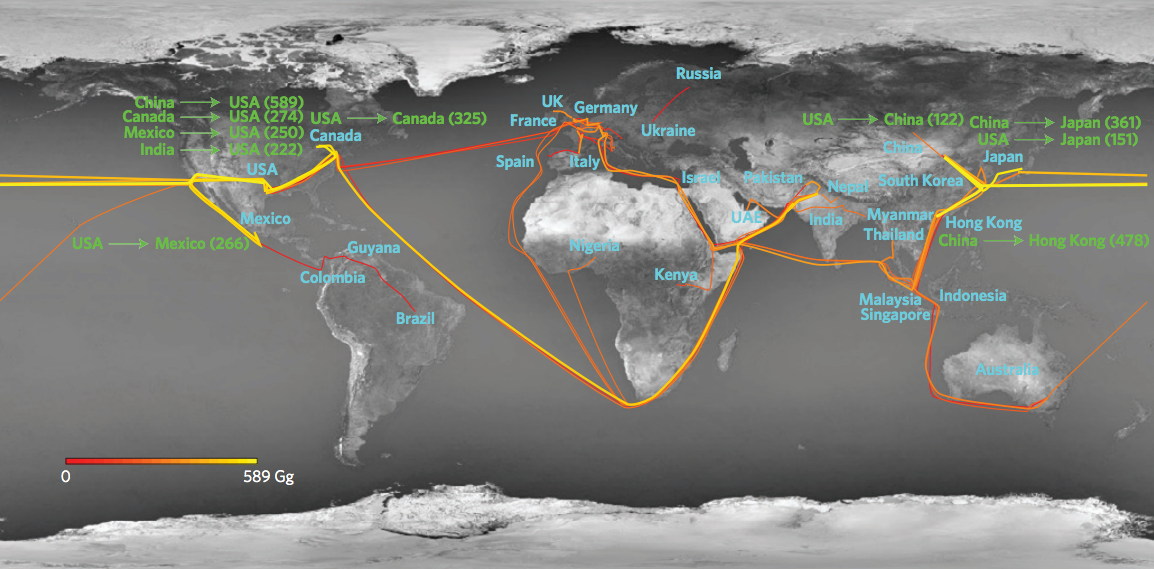
New study tracks nitrogen footprint of products made for export
Robert McSweeney
01.25.16Robert McSweeney
25.01.2016 | 5:21pmJust four countries – the US, China, India and Brazil – are responsible for almost half of the world’s total nitrogen pollution, a new study finds.
The new research maps the nitrogen ‘footprint’ of 188 countries, and finds that around a quarter of emissions come from making products that are then traded internationally.
As most of this trade takes products from poorer countries to richer ones, nitrogen pollution in developing nations is being driven by demand for food and clothing products in developed countries, the researchers say.
Nitrogen footprint
Nitrogen pollution comes in various different forms. Some of the main sources are from burning fossil fuels in cars and power stations (nitrogen oxides), processing of textiles for clothing (nitrous oxide), rearing livestock and using fertilisers (nitrous oxide and ammonia), and water run-off from industry and farming taking nitrogen into water supplies.
Nitrogen emissions have a number of impacts on the climate, environment and human health, says Arunima Malik, a PhD student in the Integrated Sustainability Analysis group at the University of Sydney, who co-authored the new Nature Geoscience study. She tells Carbon Brief:
Some of the impacts include air pollution (leading to respiratory illnesses), acid rain, eutrophication [water pollution from high nutrient levels], and climate change. Nitrates from fertilisers can pollute groundwater – some agricultural areas are suffering so much that locals need to buy bottled water because tap water is unsafe for human consumption.
The study takes all the different forms of nitrogen emissions and converts them into a single figure, which they call a nitrogen ‘footprint’. On a global scale, the average person has a nitrogen footprint of 27kg per year, says the study, but the size of emissions – both per person and as national totals – varies hugely across the world.
Top of the per person polluting pile is Hong Kong at ~225kg per year, followed by the Netherlands at ~140kg, and Kuwait at ~100kg. The UK comes in at 17th, with a per person footprint of around double the global average. At the other end of the scale are Liberia, Moldova and Côte d’Ivoire, each with emissions of less than 7kg per person per year.
Richer countries tend to have a larger nitrogen footprint because of their consumption of animal products, processed foods, clothes, and energy-intensive products, the paper says.
But as the researchers calculated emissions according to where these products are consumed, rather than produced, the study also reveals that national footprints often extend into other countries.
Import and export
Combining databases of global emissions and international trade with a global nitrogen cycle model, the researchers tracked where products – and their emissions – originate from. As Malik explains:
In essence, we scanned and analysed 5bn global supply chains for 15,000 commodities produced in 188 countries.
Their findings show that just four countries – China (20%), India (11%), the US (10%) and Brazil (6%) – make up almost half of global nitrogen emissions (47%). And the rest of the Top 10 – Russia, Pakistan, Indonesia, Australia, Mexico and Argentina – make up another 12%.
Countries like the US and Russia are “net importers” of nitrogen emissions. This means the nitrogen they emit when producing commodities for export is less than the equivalent emissions for the products they import. For countries such as China and India, the opposite applies – they are “net exporters” so the total nitrogen emissions are higher for their exports than their imports.
Net exporters therefore bear the higher environmental and health costs of nitrogen pollution because they’re producing food and clothing that are consumed in other countries.
The chart below shows the world’s Top 10 net importers and net exporters. The bars to the right of the line show nitrogen emissions that are imported, and bars to the left show those exported. Japan is the highest importer of nitrogen emissions through its consumption of clothing made in China and meat produced in the US and Australia, the paper says.
On the other side, China is the main exporter of nitrogen emissions through its exports of clothing, fruit and vegetables.

Top 10 net importers (top graph) and net exporters (bottom graph) of nitrogen emissions. Bars show four different types of nitrogen pollution: to water (Nwp), nitrous oxide (N2O), ammonia (NH3) and nitrogen oxides (NOx). Units are gigagrams (Gg), which are equivalent to million kg. Source: Oita et al. (2016).
The map below highlights where these traded products are coming from and going to. The yellow lines show the principal trade links for nitrogen emissions.
The Top 10 trade links in terms of nitrogen emissions are shown in green. Featuring prominently is the US, which appears in eight of the Top 10, while China appears in four, and Canada and Japan in two apiece.

International flows of nitrogen emissions in traded products. Coloured lines show flows from where products were produced and then eventually consumed, with larger flows in yellow. The Top 10 flows are shown in green. Units are gigagrams (Gg), which are equivalent to million kg. Source: Oita et al. (2016).
Consumer choices
The study highlights that policies to try and cut back on emissions need to cover all types of nitrogen and take into account international trade, says Malik:
Policies addressing nitrogen pollution must be aimed at both producers and consumers – it has to be a joint effort to reduce emissions.
Making consumers aware of their nitrogen footprint may encourage them to take steps to reduce it, say Prof James Galloway from the University of Virginia and Allison Leach from the University of New Hampshire in an accompanying News & Views article:
The environmental footprint is a powerful approach that connects consumers with their environmental impacts and empowers them to make changes.
Eating less meat and tackling food waste is one way of reducing nitrogen emissions, they say. In the US, for example, eating the nationally-recommended amount of meat and cutting food waste in half would reduce US nitrogen emissions by 35%.
Malik agrees that consumers need to be part of a global effort to reduce nitrogen emissions:
We need to take consumers on board – product labelling could be one way of doing so. It’s all about better communication and informing the consumers about the impacts of their buying decisions.
Given that international trade is likely to increase in future, designing policy to deal with emissions needs information on both where the pollution is being emitted and where products are being consumed, the paper says.
Main image: Denim jeans at American Eagle Outfitters in the Herald Square shopping district in New York on Thanksgiving Day.
Oita, A. et al. (2016) Substantial nitrogen pollution embedded in international trade, Nature Geoscience, doi:10.1038/ngeo2635 & Galloway, J. N and Leach, A. M. (2015) Your feet’s too big, Nature Geoscience, doi:10.1038/ngeo2647.
-
New study tracks nitrogen footprint of products made for export
-
Just four countries – US, China, India and Brazil – are responsible for almost half the world’s total nitrogen pollution

